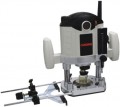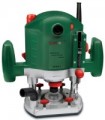Functions
—
Soft start. The presence of a soft start engine in the design of the milling cutter. A feature of most modern electric motors is that when connected to the network directly, without control circuits, at the time of start-up, there is a sharp jump in current through the motor. This, on the one hand, creates voltage fluctuations in the mains (which can “knock out” fuses or become fatal for some devices operating nearby), on the other hand, it leads to a sharp jerk of the tool, due to which it can be released from hands (and this cause damage to surrounding objects and even injury). This function also limits the current at the moment of starting the motor. Due to this, the speed increases smoothly, without jerking the tool, and the power grid is not subjected to excessive overloads.
—
Adjustment of frequency of rotation. The presence of a speed controller in the design of the milling cutter. This function allows you to change the spindle speed, adjusting it to different types of work — for example, to effectively cut hard material, you may need a high speed, and with soft woods, you can work at low speeds. Tools with speed control will be useful especially for those who have to deal with a wide variety of materials. In this case, the range of such adjustment may be different.
—
Microlift. The presence in the design of the router of a system for fine-tuning
...the depth with an accuracy of 0.1 mm. The standard setting with the limit pin is very coarse, as the errors are quite large. The microlift is used where it is important to set the depth very accurately. It is implemented mainly by means of a threaded connection that limits the vertical downward movement, or is completely integrated into the vertical travel design, where unlocking is not needed to make the necessary adjustments.
— Backlight. The presence of a lighting system in the design of the router — in fact, an ordinary flashlight that facilitates work in dimly lit places. The need for backlighting may arise even in daylight or bright artificial lighting — the place of work is quite often in the shade (for example, from the head of the operator himself).
— Maintain momentum. The presence in the design of the milling cutter of a system that automatically adjusts the engine operation mode depending on the load on the working nozzle — in such a way that the rotational speed remains constant, does not fall under load and does not increase at idle. Thanks to this adjustment, a constant quality of processing is ensured, practically independent of the pressure on the nozzle, wear of the nozzle and the tool itself is reduced, as well as overall energy consumption.Noise level
The noise level produced by the router during operation. This parameter is quite approximate, since the actual “loudness” depends not only on the characteristics of the tool itself, but also on the material and shape of the workpiece being processed, the type of cutter, the speed of work, etc. Therefore, in fact, the noise level may differ both up and down; in the characteristics, a certain average value is given, by which, however, it is quite worthwhile to navigate.
The “quieter” the tool, the more comfortable it will be to work with it, the less likely it is that the operator will need protective headphones. At the same time, we note that routers, by definition, are quite noisy — the most “quiet” models give out about 75 dB. Also, keep in mind that the decibel is a non-linear quantity, so it is best to use comparison tables when estimating the noise level.
Here is a simplified version of such a table for the range in which most modern routers operate:
75 dB — scream, loud laughter at a distance of 1 m;
80 dB — motorcycle engine, mechanical alarm at the same distance;
85 dB — a loud cry at the same distance;
90 dB — demolition hammer at a distance of 1 m, a freight car at a distance of 7 – 10 m;
95 dB — subway car (inside or at a distance of about 7 m).

